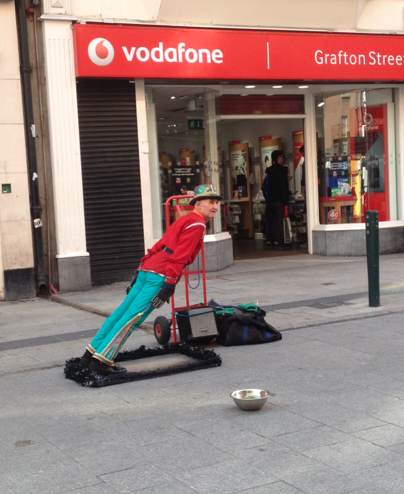 |
| Vendors' goods on Moore St. include fresh fruit, vegetables, fish, meat , and poultry. |
As I walk to my friend's apartment across the city, the first noticeable street I pass through is the ever multicultural Moore Street. Before I even turn the corner I can already hear the fruit vendors yelling their prices at the top of their lungs. "10 bananas, 1 euro!" "Seedless grapes, 1 euro!" I've probably eaten more bananas, tomatoes, and grapes in my time here than I have in my entire life!
While passing the many restaurants on the street, I don't even need to turn my head to know what I'm walking by. My senses fill my mind with thoughts of Polish, Indian, Chinese, Italian, and Thai cuisine. Just barely managing the willpower not to buy some Polish kielbasa, I continue on my journey across the city.
As I turn on to O'Connell Street, I am already standing at the General Post Office, the location of the 1916 Easter Rising and the birth of the Irish fight for independence. My professor pointed out the bullet holes in the columns out front to us last week, and I can't help but recognize them each time we pass the GPO. It is so incredible to see such a significant piece of history, still visible almost 100 years later. It's another awesome part of this unique and inspiring city that I get to experience each and every day.
My favorite street performer wasn't around today, but luckily there was a fantastic saxophonist in his place. They love to play at the corner of Henry St. and O'Connell St. for there is a ton of pedestrian traffic there.
 |
| The columns out front of the General Post Office are littered with bullet holes from the 1916 Easter Rising. |
 |
| Didn't get to see the bagpipes today, but this gentleman was a fine replacement in my eyes. |
As I pass the O'Connell bridge, I take a look down The River Liffey, and gaze upon the natural divide in Dublin city. Each side has their own little quirks; the north with their multicultural shops and restaurants, and the south with their high-end shopping centers and the famous Temple Bar area.
Street performers are aplenty in Dublin, just like any other city, and I was fortunate enough to soon lay my eyes and ears upon one of the many guitarists on Grafton St. He chose a neutral spot between Trinity College and St. Stephen's Green. This way, he doesn't have to compete with the break dancers at the top of the street. A little further down the street, I came across an older gentlemen dancing to some traditional Irish music in quite the outfit.
 |
| The years haven't caught up to this guy yet. He was doing things I couldn't imagine myself doing, even at my age! |
As I take my final steps to my French friends' apartment, I think about the football game we are about to watch. France vs. Portugal. I haven't always been a football fan, but living and studying abroad in a European capital city, it is difficult not to acknowledge the presence of it. Today I'll be rooting for Portugal, much to the chagrin of my French friends.
Rory Finnegan is the Fall 2014 CEA MOJO in Dublin, Ireland. He is currently a senior at Virginia Wesleyan College.










